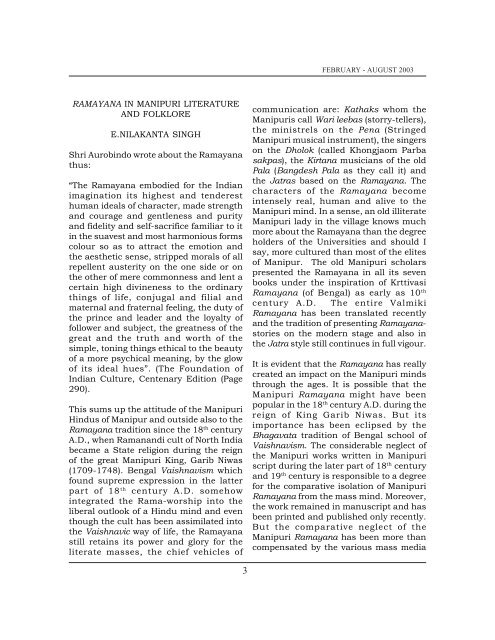Epics in Imprints-1.pdf - Vivekananda Kendra Prakashan
Epics in Imprints-1.pdf - Vivekananda Kendra Prakashan
Epics in Imprints-1.pdf - Vivekananda Kendra Prakashan
Create successful ePaper yourself
Turn your PDF publications into a flip-book with our unique Google optimized e-Paper software.
RAMAYANA IN MANIPURI LITERATURE<br />
AND FOLKLORE<br />
E.NILAKANTA SINGH<br />
Shri Aurob<strong>in</strong>do wrote about the Ramayana<br />
thus:<br />
“The Ramayana embodied for the Indian<br />
imag<strong>in</strong>ation its highest and tenderest<br />
human ideals of character, made strength<br />
and courage and gentleness and purity<br />
and fidelity and self-sacrifice familiar to it<br />
<strong>in</strong> the suavest and most harmonious forms<br />
colour so as to attract the emotion and<br />
the aesthetic sense, stripped morals of all<br />
repellent austerity on the one side or on<br />
the other of mere commonness and lent a<br />
certa<strong>in</strong> high div<strong>in</strong>eness to the ord<strong>in</strong>ary<br />
th<strong>in</strong>gs of life, conjugal and filial and<br />
maternal and fraternal feel<strong>in</strong>g, the duty of<br />
the pr<strong>in</strong>ce and leader and the loyalty of<br />
follower and subject, the greatness of the<br />
great and the truth and worth of the<br />
simple, ton<strong>in</strong>g th<strong>in</strong>gs ethical to the beauty<br />
of a more psychical mean<strong>in</strong>g, by the glow<br />
of its ideal hues”. (The Foundation of<br />
Indian Culture, Centenary Edition (Page<br />
290).<br />
This sums up the attitude of the Manipuri<br />
H<strong>in</strong>dus of Manipur and outside also to the<br />
Ramayana tradition s<strong>in</strong>ce the 18 th century<br />
A.D., when Ramanandi cult of North India<br />
became a State religion dur<strong>in</strong>g the reign<br />
of the great Manipuri K<strong>in</strong>g, Garib Niwas<br />
(1709-1748). Bengal Vaishnavism which<br />
found supreme expression <strong>in</strong> the latter<br />
part of 18 th century A.D. somehow<br />
<strong>in</strong>tegrated the Rama-worship <strong>in</strong>to the<br />
liberal outlook of a H<strong>in</strong>du m<strong>in</strong>d and even<br />
though the cult has been assimilated <strong>in</strong>to<br />
the Vaishnavic way of life, the Ramayana<br />
still reta<strong>in</strong>s its power and glory for the<br />
literate masses, the chief vehicles of<br />
3<br />
FEBRUARY - AUGUST 2003<br />
communication are: Kathaks whom the<br />
Manipuris call Wari leebas (storry-tellers),<br />
the m<strong>in</strong>istrels on the Pena (Str<strong>in</strong>ged<br />
Manipuri musical <strong>in</strong>strument), the s<strong>in</strong>gers<br />
on the Dholok (called Khongjaom Parba<br />
sakpas), the Kirtana musicians of the old<br />
Pala (Bangdesh Pala as they call it) and<br />
the Jatras based on the Ramayana. The<br />
characters of the Ramayana become<br />
<strong>in</strong>tensely real, human and alive to the<br />
Manipuri m<strong>in</strong>d. In a sense, an old illiterate<br />
Manipuri lady <strong>in</strong> the village knows much<br />
more about the Ramayana than the degree<br />
holders of the Universities and should I<br />
say, more cultured than most of the elites<br />
of Manipur. The old Manipuri scholars<br />
presented the Ramayana <strong>in</strong> all its seven<br />
books under the <strong>in</strong>spiration of Krttivasi<br />
Ramayana (of Bengal) as early as 10 th<br />
century A.D. The entire Valmiki<br />
Ramayana has been translated recently<br />
and the tradition of present<strong>in</strong>g Ramayanastories<br />
on the modern stage and also <strong>in</strong><br />
the Jatra style still cont<strong>in</strong>ues <strong>in</strong> full vigour.<br />
It is evident that the Ramayana has really<br />
created an impact on the Manipuri m<strong>in</strong>ds<br />
through the ages. It is possible that the<br />
Manipuri Ramayana might have been<br />
popular <strong>in</strong> the 18 th century A.D. dur<strong>in</strong>g the<br />
reign of K<strong>in</strong>g Garib Niwas. But its<br />
importance has been eclipsed by the<br />
Bhagavata tradition of Bengal school of<br />
Vaishnavism. The considerable neglect of<br />
the Manipuri works written <strong>in</strong> Manipuri<br />
script dur<strong>in</strong>g the later part of 18 th century<br />
and 19 th century is responsible to a degree<br />
for the comparative isolation of Manipuri<br />
Ramayana from the mass m<strong>in</strong>d. Moreover,<br />
the work rema<strong>in</strong>ed <strong>in</strong> manuscript and has<br />
been pr<strong>in</strong>ted and published only recently.<br />
But the comparative neglect of the<br />
Manipuri Ramayana has been more than<br />
compensated by the various mass media

















